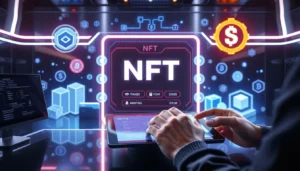How to Avoid NFT Scams: Protecting Your Digital Assets
When you explore the digital world, knowing the risks is key. NFTs have opened new doors, but they’ve also brought more scams. It’s important to watch out for NFT scams.

Safeguarding your digital holdings requires constant vigilance and proactive measures. The right security steps can protect your NFTs from scammers. Self-protection knowledge is the strongest shield against potential threats.
It’s essential to know how to keep your digital assets safe. By learning how to avoid NFT scams, you can protect your investments. This way, you can enjoy the benefits of owning NFTs without worry.
Table of Contents
Understanding the NFT Landscape
To safely explore the world of NFTs, it’s key to know the basics. NFTs, or Non-Fungible Tokens, have revolutionized ownership in digital art and rare collectibles.
What Are NFTs and Why Are They Valuable?
NFTs offer a special way to buy, sell, and trade digital items. They are valuable because they provide ownership and scarcity in the digital world.
What makes NFTs valuable is their inherent uniqueness, permanently recorded and authenticated on distributed ledgers. This uniqueness is checked by blockchain technology. This makes NFTs tamper-proof and transparent.
- Artists and creators can now generate revenue straight from their digital works without intermediaries.
- NFTs introduce a fresh approach for enthusiasts to acquire and exchange exclusive digital assets.
- Blockchain ensures each NFT’s legitimacy and traceable ownership history.
The Growth of the NFT Market
The NFT market has seen a big rise, with more sales and transactions over the years. This growth has drawn in artists, collectors, and investors looking for new chances.
The NFT market’s growth has led to new marketplaces and platforms. This makes it easier for people to get involved with NFTs.
Why NFTs Are Targets for Scammers
The rising prominence of NFTs has made them a prime target for opportunistic fraudsters. Fraudsters exploit the NFT market’s rapid growth, capitalizing on gaps in user knowledge and oversight.
- Fake marketplaces and websites are set up to trick buyers.
- Counterfeit NFTs and plagiarized art are common scams in the NFT space.
- Some manipulate NFT prices through orchestrated hype-and-dump tactics.
Common Types of NFT Scams
When you explore the NFT market, knowing about scams is key. Scammers keep changing their tricks. So, it’s vital for everyone to stay alert.
NFT scams can be many things, like fake shops or fake digital art. Knowing about these dangers helps protect your digital stuff.
Fake Marketplaces and Websites
Fake marketplaces or websites are a big scam in NFTs. They look real but are not. They aim to steal your wallet info or money.
To stay safe, check the URL of any marketplace. Be careful of emails or messages that seem too good to be true.
Counterfeit NFTs and Plagiarized Art
Scammers also make fake NFTs or copy art. They trick buyers into getting worthless or fake items. Research the creator and project thoroughly before committing funds. Make sure the art is real and the NFT is on trusted sites.
Pump and Dump Schemes
Pump and dump schemes are common in NFTs. Scammers make an NFT seem valuable by spreading lies. Then, they sell, causing prices to drop and losses for others. Watch out for sudden price jumps. Always research before buying an NFT that’s quickly rising in value.
Rug Pulls and Abandoned Projects
Rug pulls happen when developers create an NFT project, hype it, and then leave. They take investors’ money. These scams promise big returns or special perks to get people to invest.
To avoid rug pulls, look into the project team and their plans. Be cautious of projects with unknown teams or unclear goals.
Red Flags to Watch For in NFT Projects
When exploring the NFT market, it’s important to watch out for certain signs. Spotting these early warning signs can steer you clear of risky NFT ventures. Knowing what to look out for can save you from financial loss.
Anonymous or Unverified Creators
One big warning sign is when creators are unknown or unverified. Good projects usually have clear teams with real names. It’s wise to check out the creators’ backgrounds to see if they’re trustworthy.
Unrealistic Promises of Returns
Be careful of projects that promise too much profit or guaranteed success. Such claims often hide scams aimed at new investors. Remember, big profits in NFTs usually mean big risks.
Poor Quality Artwork or Metadata
The quality of the artwork and metadata matters a lot. Bad artwork or copied work might mean a scam. Make sure the NFT’s details are right and show the artwork well.
Suspicious Social Media Activity
Watch out for odd social media signs like fake followers or too much hype. Real projects have real fans. Check the project’s social media to see if it feels real.
Identifying Red Flags: A Summary
Here’s a quick guide to spotting NFT scams:
| Red Flag | Description | Action |
|---|---|---|
| Anonymous Creators | Lack of transparency about the team | Research the team and verify identities |
| Unrealistic Returns | Promises of unusually high or guaranteed returns | Be cautious and understand the risks |
| Poor Quality Artwork | Low-quality or plagiarized artwork and metadata | Verify the artwork’s authenticity and quality |
| Suspicious Social Media | Fake followers or overly promotional content | Analyze community engagement and authenticity |
A well-defined project roadmap reflects commitment and long-term vision. Stay alert and make smart choices.

Researching NFT Projects Before Investing
Before investing in an NFT project, it’s key to do your homework to dodge scams. While the NFT space offers innovation, it also harbors potential pitfalls. By carefully checking out an NFT project, you can make smarter choices and lower your risk of scams.
Investigating the Project Team
Start by looking into the team behind the NFT project. Find out about the founders, developers, and advisors. A good project will have a clear team with real credentials and past successes. Check their social media and professional networks like LinkedIn. Be cautious of projects with unknown or unverified team members.
Examining the Project Roadmap
While technical expertise helps, user-friendly tools simplify the process. It should list clear goals, timelines, and future plans. Watch out for projects with vague or overly ambitious roadmaps. A real project will have a roadmap that’s both bold and realistic.
Analyzing Community Engagement
Community activity can tell you a lot about an NFT project. Look for active talks on social media, Discord, and forums. A lively community is a good sign. But a project with little community or overly positive feedback might be a scam.
Reviewing Smart Contract Code
Smart contracts are critical for many NFT projects. Look at the code to understand how the project works and spot any risks. In the evolving NFT landscape, securing your digital wallet is non-negotiable. Make sure the smart contract has been checked by trusted auditors.
By doing your research, you can avoid NFT scams and make better choices. Always be careful and patient. Take your time to research and don’t jump into anything that seems too good to be true.
Securing Your Digital Wallet
Understanding wallet protection methods is vital to safeguarding your investments.
Choosing a Reputable Wallet
First, pick a trusted digital wallet. With numerous options available, thorough research is essential. Choose wallets with proven security features and positive user feedback.
- Research the wallet’s security features and history.
- Check for user reviews and ratings.
- Ensure the wallet is compatible with the blockchain networks you’re using.
Setting Up Two-Factor Authentication
Adding two-factor authentication (2FA) boosts your wallet’s security. It asks for a second verification, like a code on your phone, along with your password. Enhanced security measures deter unauthorized access attempts.
To set up 2FA:
- Go to your wallet’s security settings.
- Select the option to enable 2FA.
- Sync your mobile or authentication app by following the setup prompts.
Creating Strong, Unique Passwords
Assign unique, intricate passwords to every wallet and connected platform. Avoid predictable passwords; combine random characters, digits, and special symbols for stronger security.
- Use a password manager to generate and store unique passwords.
- Avoid using the same password across multiple accounts.
- Regularly update your passwords to maintain maximum security.
Using Hardware Wallets for Large Investments
For big NFT investments, think about a hardware wallet. These wallets keep your private keys offline, making them safer from hackers. They’re great for big crypto or NFT collections.
Implementing these strategies significantly boosts your wallet’s defenses. This helps protect your NFTs from scams and unauthorized access.

Safe Practices for NFT Marketplaces
When you use NFT marketplaces, you need to be careful to avoid scams. Awareness of best practices is key to defending your digital portfolio.
Tips for creating strong passwords:
Identifying Legitimate Marketplaces
Finding safe NFT marketplaces is the first step. Choose platforms with a good reputation, clear rules, and strong security. Check the platform’s history, team, and any partnerships.
Stay away from new platforms without a track record or unclear rules. Also, see if they’re on reputable sites or in well-known publications.
Understanding Platform Fees and Policies
Before you start, know the fees and rules of the marketplace. Understand listing, transaction, and royalty fees. Also, know the platform’s policies on copyright, account suspension, and disputes. Scrutinizing terms of service avoids unexpected issues seek clarification when needed.
Verifying Collection Authenticity
It’s key to check if NFT collections are real. See if the marketplace verifies them or if the creator’s site or social media says they’re authentic.
Be careful of collections with little info on creators or history. Tools that check NFTs can add extra security.
Reading User Reviews and Ratings
User feedback is helpful in choosing NFT marketplaces. Look for comments on customer support, ease of use, and issues. This evaluation ensures a marketplace aligns with your needs.
Some reviews might be fake. Look for detailed, balanced reviews that mention both good and bad points.
Protecting Yourself from Phishing Attacks
To keep your NFTs safe, it’s key to know about phishing attacks. These scams use fake emails, messages, and websites to get your personal info.
Recognizing Phishing Emails and Messages
Phishing emails and messages seem real but aim to trick you. Be wary of unsolicited requests for your credentials or wallet access. Scammers might use real company logos to look legit.
To spot phishing, look for:
- Spelling and grammar mistakes
- Urgent or threatening language
- Suspicious sender email addresses
- Requests for sensitive information
Avoiding Suspicious Links
Don’t click on links from unknown sources. Scammers use links to lead victims to fake sites that look like real NFT places or wallets. Type the URL in your browser or use bookmarks instead.
Verifying Website URLs
Always check the website’s URL. Scammers make fake sites that look similar to real ones. Look for “https” and a lock icon in the address bar to make sure it’s safe.
| Legitimate URL Features | Suspicious URL Features |
|---|---|
| https in the URL | http or missing https |
| Lock icon in the address bar | Missing lock icon |
| Correct spelling of the domain name | Misspelled or similar domain name |
Using Browser Extensions for Security
Think about using browser extensions to block phishing sites. These extensions can help keep you safe when you’re on NFT sites.
Understanding Smart Contract Risks
Smart contracts are key to NFT transactions, but can be risky if not understood. Understanding NFT mechanics and associated risks is crucial before investing.
What Are Smart Contracts?
Programmed to operate autonomously, smart contracts trigger actions once their built-in requirements are fulfilled. They manage NFT trades, making them secure and clear. They eliminate intermediaries, allowing peer-to-peer exchanges without third parties.
But smart contracts are not perfect. Code flaws can be used by bad actors, risking your NFT investments.
Common Smart Contract Vulnerabilities
Smart contracts face several risks, including:
- Reentrancy attacks
- Front-running attacks
- Unsecured external calls
- Integer overflow and underflow
These issues can lead to fund theft or NFT transaction tampering. Knowing these risks is key when investing in NFTs.
Tools for Verifying Smart Contracts
To lessen smart contract risks, use tools to check their safety. Some tools include:
- Contract analyzers
- Security auditors
- Blockchain explorers
These tools spot possible weaknesses and confirm the contract’s safety.
The Importance of Audited Contracts
Audited contracts add security for NFT investors. Audits deeply check the contract code for flaws. Choosing NFTs with audited contracts lowers scam risks.
Always look for audited smart contracts in NFT projects. This check can prevent financial losses.

Recognizing NFT Scams in Social Media and Discord
When exploring the NFT world, it’s key to watch out for scams on social media and Discord. Scammers hide in these places, aiming at new fans and investors. Staying informed and cautious helps you navigate risks effectively.
Fake Giveaways and Airdrops
Scammers often set up fake giveaways and airdrops. They might use enticing offers to get your info or crypto. This is a common trick.
To dodge these scams, check if giveaways and airdrops are real. Look for official accounts of the NFT project or platform. Be careful of accounts with slight variations in their handles or email addresses.
Impersonation Scams
Fake profiles and imposters thrive on platforms like Twitter and Discord. Scammers pretend to be big names or project owners. Their goal is to steal cryptocurrency or sensitive personal data.
To stay safe, always verify the identity of people or accounts asking for your info or crypto. Look for verification badges on social media. Be wary of generic or poorly written messages.
Discord Server Hacks
Discord server hacks are a big worry for NFT groups. Scammers get into servers and post fake stuff or links to phishing sites. These seem real because they come from trusted sources.
Stay cautious with unverified links or sudden announcements, even from trusted sources. Always check info through official channels or multiple sources before acting.
Protecting Your Social Media Accounts
Keeping your social media accounts safe is vital to avoid NFT scams. Use strong, unique passwords and turn on two-factor authentication (2FA) for extra security.
Watch your accounts for anything odd and be on guard against phishing attempts. Regular updates patch vulnerabilities, reducing exposure to cyber threats.
What to Do If You’ve Been Scammed
Swift action after an NFT scam can help minimize financial damage. The actions you take right after finding out can greatly affect your chances of getting back what’s lost.
Reporting the Scam to Authorities
First, report the scam to the right people. Report incidents to authorities like the FTC or local law enforcement. Share all the details you have, like transaction records and talks with the scammers.
Keep a record of your report. Document timestamps, case numbers, and relevant details for reference. This info will help with future steps.
Contacting the Marketplace Support
If the scam happened on a specific NFT marketplace, get in touch with their support team right away. Good marketplaces have ways to deal with scams. They might freeze the scammer’s account or help get back your assets.
Provide support teams with comprehensive information for faster resolution. This includes transaction IDs, wallet addresses, and any messages with the scammer.
Warning the Community
After taking care of your account and reporting the scam, let others know about it. Sharing your experience on forums and social platforms can prevent further victimization.
When sharing your story, use simple and clear language. Share identifiable scam patterns to protect the wider community.
Recovering from Financial Loss
Getting back from a financial loss from an NFT scam is tough. But there are steps you can take. Check your finances and talk to a financial advisor if needed.
In some cases, you might be able to get your money back through insurance or other ways. It’s important to look into all options and get professional advice if you can.
The Future of NFT Security
The future of NFT security is being shaped by new technologies, laws, and community efforts. As the NFT ecosystem expands, staying updated on security trends is essential for all participants.
Emerging Security Technologies
New tech is coming to make NFTs safer. Multi-signature wallets demand approvals from several keys before processing any transaction. This added layer of security prevents unsanctioned withdrawals.
Blockchain forensics is another new tech. It analyzes blockchain data to spot and track suspicious activities. Early detection mechanisms help identify and curb fraudulent NFT activities.
Regulatory Developments
Regulators are now focusing on the NFT space. They aim to protect buyers and keep the market fair. Stricter rules might be made to stop scams and ensure marketplaces are open.
These new rules could greatly help the NFT world. They might lower scam risks and build more trust among investors.
Community-Led Security Initiatives
The NFT community is also working hard to improve security. Community-led efforts include making open-source security tools and hosting workshops. These help teach people about NFT security.
- Open-source security tools for NFT investors
- Workshops on identifying and avoiding NFT scams
- Collaborative efforts to share knowledge and best practices
Education and Awareness Programs
Learning is key to better NFT security. Knowing the risks and how to avoid them helps protect everyone. Educational initiatives are raising awareness about NFT security risks. These programs cover important topics. Staying informed helps you navigate the space without falling prey to fraud.
Conclusion
Keeping your digital assets safe in the NFT world needs awareness, research, and good security habits. Knowing about common NFT scams and staying up-to-date with the NFT market helps lower your risk. Recognizing these indicators and responding wisely reduces scam susceptibility.
To dodge NFT scams, be careful when you invest in NFTs. Look into the team behind the project, check the project’s plan, and see how active the community is. Also, make sure your digital wallet is secure by picking a trusted one and enabling two-factor authentication.
By following these tips and staying alert, you can enjoy NFTs while keeping your digital assets safe from scams. Being informed and using good security practices is key to how to avoid NFT scams. This ensures a safe and successful NFT investment journey.
FAQ
What are NFTs, and why are they valuable?
NFTs, or Non-Fungible Tokens, are unique digital assets. They represent ownership of items like artwork, music, or collectibles. They’re valuable because they prove ownership and scarcity, attracting collectors and enthusiasts.
How can I identify a legitimate NFT marketplace?
Look for marketplaces with a strong reputation and clear policies. Check their history, read user reviews, and verify the authenticity of listed collections.
What are some common types of NFT scams?
Scams include fake marketplaces, counterfeit NFTs, and pump and dump schemes. Be cautious of unsolicited offers and research the project team before investing.
How can I protect myself from phishing attacks in the NFT space?
Be cautious of suspicious emails and messages. Avoid unknown links and verify website URLs. Use security browser extensions.
What are smart contract risks, and how can I mitigate them?
Smart contract risks are vulnerabilities that scammers can exploit. Research the code, use security tools, and look for audited contracts. Understand the contract terms before using it.
How can I recognize NFT scams on social media and Discord?
Scams on social media and Discord include fake giveaways and impersonation. Be cautious of unsolicited messages and verify identities. Watch out for suspicious links or attachments.
What should I do if I’ve been scammed in the NFT space?
Report the scam to the authorities and contact the marketplace support. Warn the community and take steps to recover financially. Seek professional advice or report to law enforcement.
How can I stay informed about the latest NFT security threats and best practices?
Follow reputable sources and participate in community discussions. Attend education programs. Stay updated with security technologies and regulations.
What are some best practices for securing my digital wallet?
Choose a reputable wallet provider and use two-factor authentication. Create strong passwords and consider a hardware wallet for big investments. Update your wallet software and watch out for phishing.
How can I verify the authenticity of an NFT project?
Research the project team and examine the roadmap. Analyze community engagement and review the smart contract code. Look for red flags like anonymous creators or unrealistic promises.







